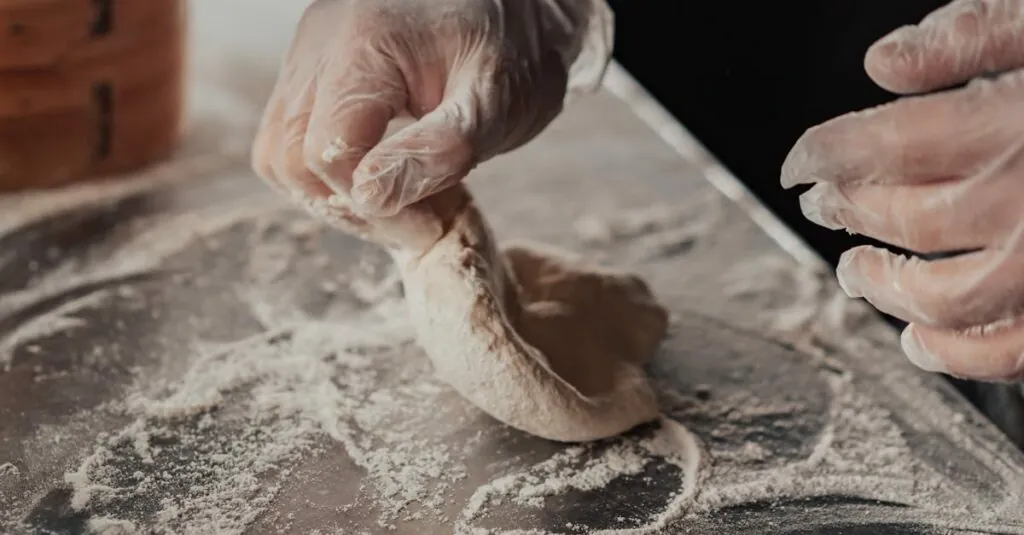Table of Contents
ToggleIn the bustling world of culinary delights, understanding cooking methods is like having a secret map to flavor town. Whether it’s the sizzle of a steak on a grill or the gentle simmer of a stew, each technique brings its own magic to the table. But what exactly is a cooking method? Simply put, it’s the way food is transformed from raw ingredients into mouthwatering masterpieces.
Understanding Cooking Method Definition
Understanding a cooking method involves recognizing various techniques used to prepare food. A cooking method can be classified into several categories, such as dry heat, moist heat, and combination methods. Each category employs specific processes to manipulate ingredients.
Dry heat methods include techniques like roasting, baking, and grilling. These methods focus on using hot air or direct heat to create flavorful dishes. Baking bread or grilling chicken illustrates how the application of dry heat transforms texture and flavor.
Moist heat methods encompass processes such as boiling, steaming, and braising. These techniques rely on water or steam to cook food, often resulting in tender textures. Boiling pasta and steaming vegetables showcase the effectiveness of moisture in enhancing natural flavors.
Combination methods utilize both dry and moist heat to achieve desired outcomes. Techniques like braising and stewing combine initial searing with slow cooking in liquid. These methods effectively break down tougher cuts of meat, yielding rich and complex flavors.
Each cooking method affects the final flavor, texture, and nutritional profile of the dish. Roasting vegetables caramelizes their sugars, while steaming retains more nutrients. The choice of method impacts the overall dining experience.
Familiarity with various cooking methods empowers individuals to experiment with meals. Chefs and home cooks alike can tailor their approach based on desired flavors and textures. Mastering these techniques contributes significantly to culinary skill development.
Types of Cooking Methods
Understanding various cooking methods enhances culinary skills and creativity. Three primary categories of cooking methods exist: dry heat, moist heat, and combination methods.
Dry Heat Cooking Methods
Dry heat cooking methods utilize direct heat or hot air to prepare food. Techniques such as roasting, baking, and grilling fall into this category. Roasting enhances flavors through caramelization, while grilling adds a distinct char. Baking provides an even cooking environment suitable for bread and pastries. Each method highlights the food’s natural flavors, creating appealing textures.
Moist Heat Cooking Methods
Moist heat cooking methods incorporate water or steam to cook food. Techniques like boiling, steaming, and braising are common examples. Boiling cooks food evenly and quickly, while steaming preserves nutrients and color. Braising combines both moisture and heat, perfect for tenderizing tough cuts of meat. These methods result in dishes that are often juicy and flavorful.
Combination Cooking Methods
Combination cooking methods merge dry and moist heat to achieve ideal textures and flavors. Techniques such as braising and stewing showcase this approach effectively. Braising starts with searing in a dry method before simmering in liquid. Stewing involves cooking smaller pieces of food in a flavor-rich liquid, allowing them to absorb excellent tastes. These methods are particularly effective for tougher meats, leading to rich, savory dishes.
Factors Influencing Cooking Methods
Various factors shape the choice of cooking methods, including cuisine, cultural influences, and nutritional considerations. Understanding these factors enhances cooking practices and outcomes.
Cuisine and Cultural Influences
Cuisine differences significantly affect cooking method selection. Regional traditions offer unique techniques that highlight local ingredients. Italian cuisine often emphasizes pasta preparation through boiling, while Asian cuisine leans toward steaming and stir-frying for fresh vegetables. Influence from cultural heritage also dictates preferences, with certain communities favoring grilling as a communal cooking experience. These practices create a sense of identity and show how geographical elements impact culinary choices.
Nutritional Considerations
Nutritional factors play a crucial role in determining cooking methods. Some techniques, like steaming, maintain nutrients better than others, such as boiling, which can lead to nutrient loss in water. Choices between dry and moist methods influence calorie content and fat retention as well. Grilling typically reduces fat, while slow braising can enhance flavors through added oils. By considering health impacts, cooks can select methods that align with dietary goals while preserving or enhancing the nutritional value of meals.
The Importance of Cooking Method Definition
Understanding cooking methods plays a crucial role in culinary success. Each method transforms raw ingredients into finished dishes, highlighting unique flavors and textures. Knowledge of dry heat techniques, including roasting and grilling, brings out natural sweetness and creates appealing textures. Roasting caramelizes sugars, while grilling imparts a distinctive char, enhancing flavor profiles.
Moist heat methods such as boiling and steaming offer different advantages. Boiling cooks food quickly and evenly, making it ideal for pasta and vegetables. Steaming retains nutrients, preserving both color and flavor, which contributes positively to dish quality. Braising combines moisture with heat, effectively tenderizing tougher cuts of meat for savory results.
Combining dry and moist heat methods results in enriching dishes. Techniques like braising often begin with searing followed by simmering in liquid, producing enhanced taste. Stewing involves smaller pieces of food cooked in flavor-rich broth, maximizing richness. This fusion approach is especially effective for developing deeper flavors.
Cultural influences significantly shape the choice of cooking methods. Each region showcases unique techniques that reflect local ingredients and traditions. For example, Italian cuisine prioritizes boiling for pasta, while Asian cooking often focuses on steaming and stir-frying vegetables. The selection process also accounts for nutritional considerations, with steaming preserving more essential nutrients compared to boiling.
Culinary flexibility emerges from understanding these methods. Chefs and home cooks can explore various techniques to optimize flavor, texture, and nutritional value in their meals. This expertise leads to improved cooking skills, allowing individuals to create dishes tailored to their tastes and dietary preferences.
Mastering cooking methods is essential for anyone looking to elevate their culinary skills. By understanding the nuances of dry heat, moist heat, and combination techniques, cooks can unlock a world of flavors and textures. This knowledge not only enhances the taste of dishes but also allows for greater creativity in the kitchen.
Culinary practices are deeply rooted in cultural traditions and nutritional considerations, making the selection of cooking methods a personal and informed choice. Embracing these methods enables cooks to adapt recipes to their preferences and dietary needs, resulting in meals that are not only delicious but also satisfying. With this foundation, both novice and experienced cooks can confidently explore the vast landscape of cooking.




